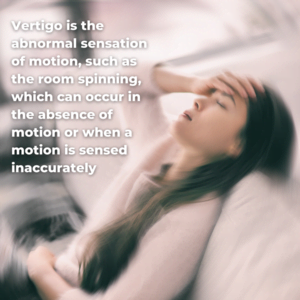There exists a misconception that Physiotherapy solely relates to musculoskeletal problems and rehabilitation. But the scope of practice of a Physiotherapist far exceeds that of muscle, tendon, ligament, bone or joint pathology. There are countless numbers of specializations within Physiotherapy such as incontinence, oncology, stroke or neurological deficits, and vestibular disorders. Of these groups of specializations, sporadic dizziness or Vertigo is a condition commonly seen and treated in private practice.

What is Vertigo?
Vertigo is the abnormal sensation of motion which can occur in the absence of motion or when the motion is sensed inaccurately. The overall incidence of balance and dizziness problems is approximately 5-10% within the general population. This increases to 40% with those over 40 years in age but most commonly occurs between the ages of 50 to 70 and affects women more frequently than men.
Why do you get Vertigo?
There are various possible reasons why someone maybe experiencing dizziness. Through careful examination and questioning, the Physiotherapist must determine the origin of the dizziness. The cause of dizziness could be from a cardiovascular problem (arrhythmia or orthostatic hypotension), visual impairments, metabolic disorder (hypoglycemia), cervicogenic origins (altered sensory input from the neck) or a vestibular problem (central/brain & peripheral/inner ear).
Benign Postitional Paroxysmal Vertigo (BPPV)
Most commonly seen and addressed in physiotherapy is Benign Positional Paroxysmal Vertigo. Benign Positional Paroxysmal Vertigo (BPPV) refers to a prevalent problem affecting the inner ear that presents as dizziness or vertigo.
The inner ear is composed of 3 semicircular canals crossed with each other, the utricle and saccule, which possess in its interior some crystals, known as otoconia or otoliths. These structures have the objective of keeping a normal balance sensation during everyday life. The semicircular canals are a series of what are essentially tubes that exist in pairs on either side of our head. These canals provide information to the brain on the position and movement of our head through space. Each canal is paired to the opposite one on the other side of our head and they are a highly coordinated system that can detect very small changes in position and posture.
BPPV is thought to occur when a small crystal or clump of cellular debris (the body’s own tissues) ends up in a part of our semicircular canals where it does not belong. The current hypothesis is that these crystals can sometimes be dislodged and inappropriately move into the semicircular canals. The accumulation of these crystals or cellular debris interferes with the normal flow within the semicircular canal sending an abnormal balance signal to the brain, producing dizziness.
BPPV Symptoms
A typical presentation of BPPV will be of an individual who reports episodes of dizziness or the sensation that the room is spinning (vertigo) when they position themselves or their head in a certain way. The vertigo will sometimes last for only a minute or two, but in rare cases will continue until the position is changed.
Many people will learn how to avoid symptom creating positions and some can go days at a time without an episode if they restrict their activity. In some cases, BPPV will resolve spontaneously. The body has the capacity to reabsorb the clump of cells and things will return to normal once the crystals are gone. On the other hand, sometimes people will experience episodic or constant symptoms that can last for months.
BPPV Treatment
Even after successful treatment, there is the chance that the condition will reoccur. However, this can typically be resolved with the appropriate treatment. I recommend to immediately seek an assessment from a Physiotherapist who understands BPPV. They can provide you with the various treatment options that exist for you to quickly resolve your dizziness concerns.
Nic Pahud
Physiotherapist at Pivotal Physiotherapy
